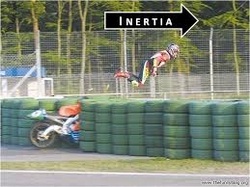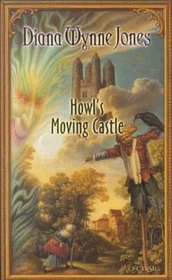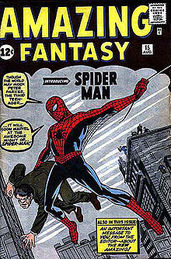
I recently read this article by Bradley P. Beaulieu, discussing ways in which characters change and grow and whether or not this is necessary to a good story. This had me thinking not only about the ways in which characters might change, but the reasons for them—what inspires characters to change, either consciously or unconsciously, and which of these are most effective for a story?
The thing is, people don’t like to change—we’re a rather sedentary species. The saying “if it ain’t broke, don’t fix it” is an attitude for more than just appliances, and inertia affects more than just objects:
“An object at rest stays at rest and an object in motion stays in motion with the same speed and in the same direction unless acted upon by an unbalanced force.” —Newton’s First Law of Motion (aka the Law of Inertia)
So what sort of “unbalanced force” can make a character change?
The thing is, people don’t like to change—we’re a rather sedentary species. The saying “if it ain’t broke, don’t fix it” is an attitude for more than just appliances, and inertia affects more than just objects:
“An object at rest stays at rest and an object in motion stays in motion with the same speed and in the same direction unless acted upon by an unbalanced force.” —Newton’s First Law of Motion (aka the Law of Inertia)
So what sort of “unbalanced force” can make a character change?

1. Forced Change
As Beaulieu points out in his article, some stories are built around “pressing on someone’s blind spot and forcing them to change,” which can lead to either a strengthening or improvement in the character (think Jaime Lannister from A Song of Ice and Fire, the knight who loses his swordhand and becomes indebted to a woman he reviles, but when he finally reaches the family he’s been trying to return to he sees them through a newfound lens of righteousness) or a drastic devolution (Theon Greyjoy, same series, the cock-sure “Prince” who is maimed and tortured until he has the self-confidence of a suicidal flea). These are external changes whereby someone else strips the character of some defining trait such that the character must re-determine every aspect of themselves—often for the worse. This negative change can alienate readers, “because readers don’t always sympathize with unsavory characters, or characters that lose their heroic traits, but with the right mix, they can become very memorable for the simple fact that they don’t fall into the mold of the typical hero.”
As Beaulieu points out in his article, some stories are built around “pressing on someone’s blind spot and forcing them to change,” which can lead to either a strengthening or improvement in the character (think Jaime Lannister from A Song of Ice and Fire, the knight who loses his swordhand and becomes indebted to a woman he reviles, but when he finally reaches the family he’s been trying to return to he sees them through a newfound lens of righteousness) or a drastic devolution (Theon Greyjoy, same series, the cock-sure “Prince” who is maimed and tortured until he has the self-confidence of a suicidal flea). These are external changes whereby someone else strips the character of some defining trait such that the character must re-determine every aspect of themselves—often for the worse. This negative change can alienate readers, “because readers don’t always sympathize with unsavory characters, or characters that lose their heroic traits, but with the right mix, they can become very memorable for the simple fact that they don’t fall into the mold of the typical hero.”

It is perhaps because of this potential for alienation that this sort of change is more often found earlier in a character arc, before the reader becomes too attached to the character as he or she originally was—it can make for a very effective inciting incident. Howl’s Moving Castle, for example, begins with an evil witch sweeping in and transforming the teenaged protagonist into an old woman, turning her entire life upside down. While the original Sophie is cautious and demure, her attitude after the curse is pretty much that of “fuck it”—when she falls in with the wizard that she originally lived in fear of, she embraces her new role of crone and gives him a good scolding for allowing his home to fall into disrepair.

2. Change for Survival
The first type of change that Beaulieu discusses (and the most common in all literature) is that specifically of growth—“an increase in the level of skill, the savvy of the character, or their general level of competence or ability to handle the things that life is throwing at them.” This sort of change generally comes about over a course of time, as the character adapts to his or her circumstances and learns what he or she needs to do to survive, or at least to succeed in his or her goal(s). It’s generally not so much a conscious decision to change so much as a natural progression—the character doesn’t really have a choice in the matter—so, while satisfying for the reader, it’s not terribly dramatic.
A basic example of this is the plot of The Karate Kid: protagonist is bullied by students at a pro-aggressive karate school, so he enters training with a more pacifistic karate master, has some montages, and in the end he wins a tournament. He changes by becoming better at karate—but what else was he going to do? Take the daily beating? Once the teacher entered the scene, there was no doubt that the protagonist would learn to defend himself and earn the respect of the bullies. It was inevitable, and the ending was what it had to be, but there are no real changes in the character that didn’t stem directly from what he had to do to succeed. Still, this straightforward growth is a cornerstone of literature for a reason: it is cathartic and gratifying to watch a character meet or exceed the demands of his or her circumstance.
The first type of change that Beaulieu discusses (and the most common in all literature) is that specifically of growth—“an increase in the level of skill, the savvy of the character, or their general level of competence or ability to handle the things that life is throwing at them.” This sort of change generally comes about over a course of time, as the character adapts to his or her circumstances and learns what he or she needs to do to survive, or at least to succeed in his or her goal(s). It’s generally not so much a conscious decision to change so much as a natural progression—the character doesn’t really have a choice in the matter—so, while satisfying for the reader, it’s not terribly dramatic.
A basic example of this is the plot of The Karate Kid: protagonist is bullied by students at a pro-aggressive karate school, so he enters training with a more pacifistic karate master, has some montages, and in the end he wins a tournament. He changes by becoming better at karate—but what else was he going to do? Take the daily beating? Once the teacher entered the scene, there was no doubt that the protagonist would learn to defend himself and earn the respect of the bullies. It was inevitable, and the ending was what it had to be, but there are no real changes in the character that didn’t stem directly from what he had to do to succeed. Still, this straightforward growth is a cornerstone of literature for a reason: it is cathartic and gratifying to watch a character meet or exceed the demands of his or her circumstance.

3. Change by Exemplar
Change sometimes comes about when a character admires a trait in another character and either chooses independently to try to emulate it or, more often, is driven to by outside circumstances—often the death of the admired character. This might create a vacuum which the changing character must step forward to fill, or the changing character will tell themselves that they must change their behavior “in honor of” the admired character (à la Peter Parker after the death of Uncle Ben).
According to psychologist Dr. Henry Cloud, “Encourage literally came from ‘in courage.’ The courage is put ‘into’ you from outside. Our character and abilities grow through internalizing from others what we do not possess in ourselves.” This internalizing of admirable traits can be effectively used at any turning point in the story, from the inciting incident to the climax, but beware of sounding trite and moralizing—most folks don’t much like being preached at.
Change sometimes comes about when a character admires a trait in another character and either chooses independently to try to emulate it or, more often, is driven to by outside circumstances—often the death of the admired character. This might create a vacuum which the changing character must step forward to fill, or the changing character will tell themselves that they must change their behavior “in honor of” the admired character (à la Peter Parker after the death of Uncle Ben).
According to psychologist Dr. Henry Cloud, “Encourage literally came from ‘in courage.’ The courage is put ‘into’ you from outside. Our character and abilities grow through internalizing from others what we do not possess in ourselves.” This internalizing of admirable traits can be effectively used at any turning point in the story, from the inciting incident to the climax, but beware of sounding trite and moralizing—most folks don’t much like being preached at.

4. Sacrificial Change
“There is something intensely interesting to me about characters getting swept into unexpected appetites, of not knowing they were going to do these things,” said literary fiction author Joan Silber, and I would add that this hinges on them doing these things because of those unexpected appetites. Characters are sometimes faced with the decision whether to change or remain the comfortable same—and for them to believably choose to change, there needs to be something awful weighty on that side of the scale. In situations where their old lifestyle isn’t being threatened in any way, there needs to be something they want even more that requires that they behave differently than they did before. This sort of change, wherever else it may be found, is a necessary plot point in the romance genre, where it is referred to as the “grand gesture.”
It is debatable whether romance is more formulaic than any other mainstream fiction genre, but what isn’t debatable is that there is a formula: mostway through is a “black moment” where the couple in question has broken up and the audience is left wondering if they’ll ever ever ever get back together, which gives each character a chance to ruminate on how much they really do love the other character and how horrid life is without them and oh, if only that Obstacle weren’t so… well, Obstructive. Once they’ve pined enough, the “black moment” is followed by the “grand gesture” wherein they make a big show of how much they’re willing to sacrifice for one another—the proud landed gentleman who always does things by the book goes against his rich aunt’s wishes and marries beneath his station, and the stubborn young lady who thought him the most pretentious windbag in the history of windbaggery puts aside her prejudices and admits that sometimes first impressions can be mistaken. (Why yes, that is the plot of Pride and Prejudice.)
Sacrificial change may not seem so very sacrificial—it’s not like their lives are on the line, jeez—but as I said earlier, people really don’t like to change. Therefore, in choosing to give up the status quo, the character proves the depth of his or her commitment to the cause that requires this change. This makes for a highly dramatic climax in any story, but especially one in which the character’s emotions are in question. Most of all, it is effective to create a story in which the character in question genuinely can’t predict whether he or she will choose to change—and neither can the reader.
So, there you have it: four different reasons why a character might change, and their pros and cons. If you can think of any more (or anything else on the topic), feel free to discuss in the comments!
“There is something intensely interesting to me about characters getting swept into unexpected appetites, of not knowing they were going to do these things,” said literary fiction author Joan Silber, and I would add that this hinges on them doing these things because of those unexpected appetites. Characters are sometimes faced with the decision whether to change or remain the comfortable same—and for them to believably choose to change, there needs to be something awful weighty on that side of the scale. In situations where their old lifestyle isn’t being threatened in any way, there needs to be something they want even more that requires that they behave differently than they did before. This sort of change, wherever else it may be found, is a necessary plot point in the romance genre, where it is referred to as the “grand gesture.”
It is debatable whether romance is more formulaic than any other mainstream fiction genre, but what isn’t debatable is that there is a formula: mostway through is a “black moment” where the couple in question has broken up and the audience is left wondering if they’ll ever ever ever get back together, which gives each character a chance to ruminate on how much they really do love the other character and how horrid life is without them and oh, if only that Obstacle weren’t so… well, Obstructive. Once they’ve pined enough, the “black moment” is followed by the “grand gesture” wherein they make a big show of how much they’re willing to sacrifice for one another—the proud landed gentleman who always does things by the book goes against his rich aunt’s wishes and marries beneath his station, and the stubborn young lady who thought him the most pretentious windbag in the history of windbaggery puts aside her prejudices and admits that sometimes first impressions can be mistaken. (Why yes, that is the plot of Pride and Prejudice.)
Sacrificial change may not seem so very sacrificial—it’s not like their lives are on the line, jeez—but as I said earlier, people really don’t like to change. Therefore, in choosing to give up the status quo, the character proves the depth of his or her commitment to the cause that requires this change. This makes for a highly dramatic climax in any story, but especially one in which the character’s emotions are in question. Most of all, it is effective to create a story in which the character in question genuinely can’t predict whether he or she will choose to change—and neither can the reader.
So, there you have it: four different reasons why a character might change, and their pros and cons. If you can think of any more (or anything else on the topic), feel free to discuss in the comments!
 RSS Feed
RSS Feed